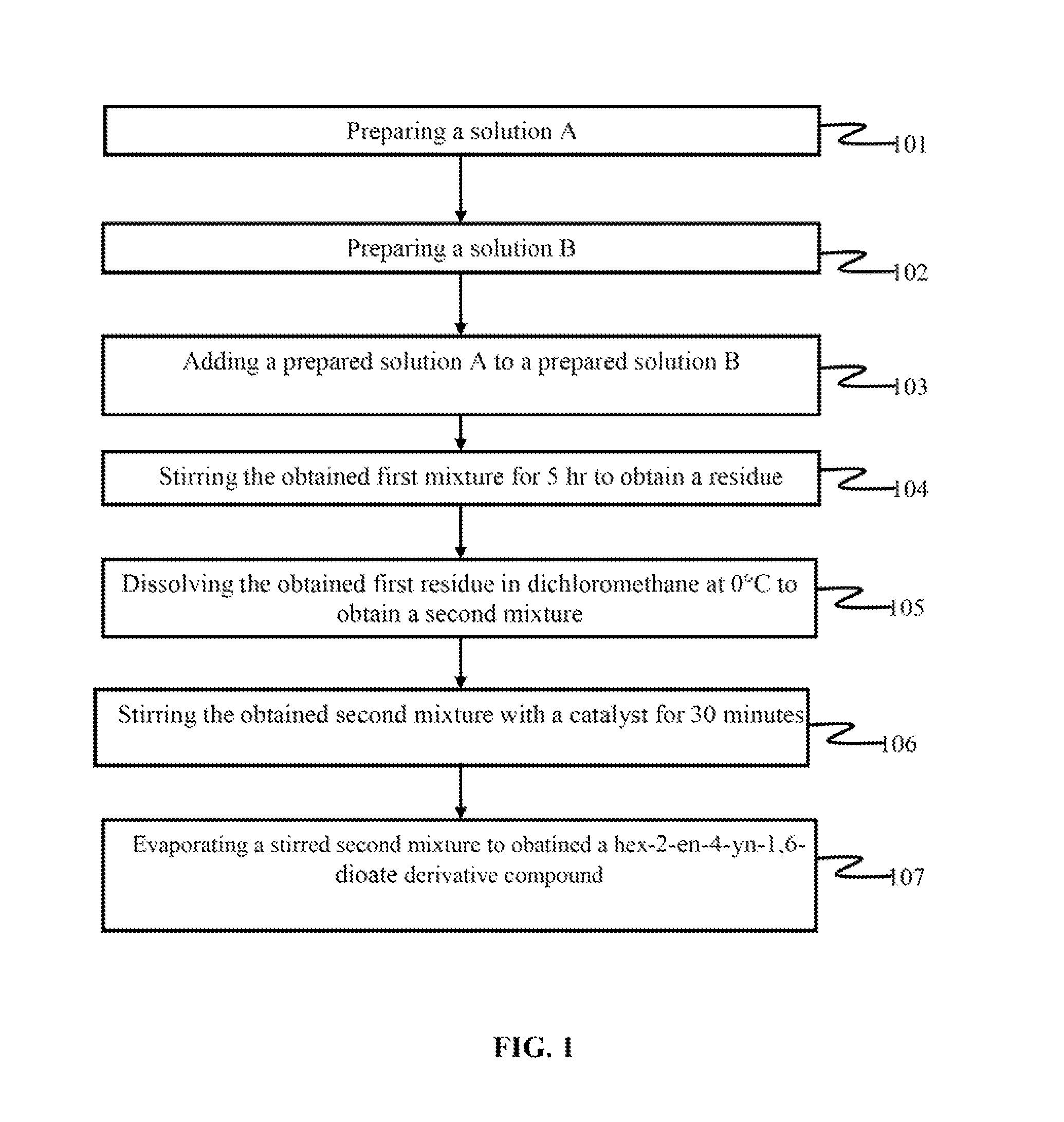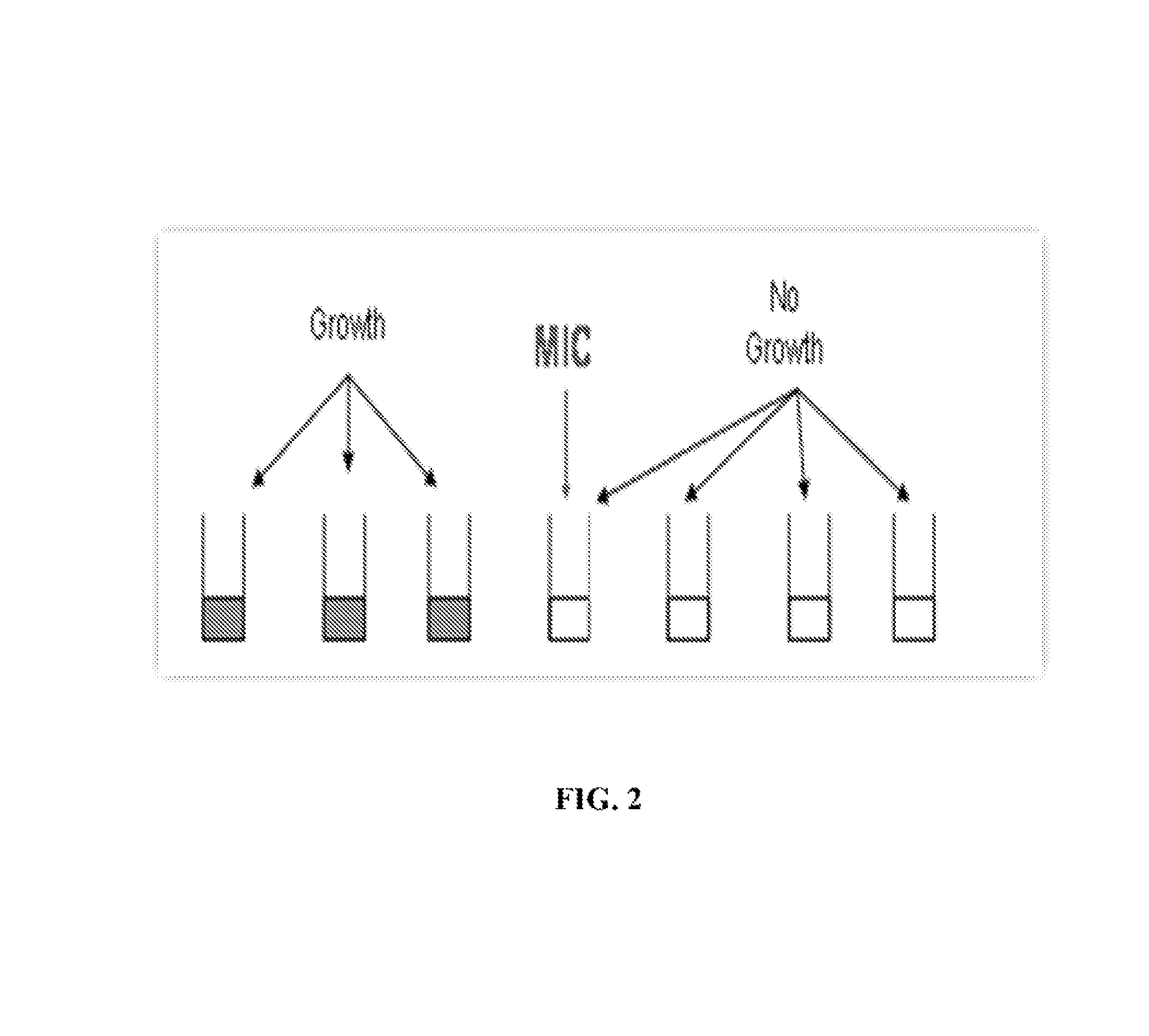Aliphatic amino acid biosynthesis inhibitors and a method of synthesizing the same
a technology inhibitors, which is applied in the field of antifungal compounds, can solve the problems of limiting the options of antimicrobial agents, organisms have created serious concerns, and fungal pathogens are a major cause of infection in humans with a high mortality rate, and achieve the effect of inhibiting the biosynthesis of aliphatic amino acids
- Summary
- Abstract
- Description
- Claims
- Application Information
AI Technical Summary
Benefits of technology
Problems solved by technology
Method used
Image
Examples
example 1
[0106]The new chemical compound is synthesized by a method comprising the steps of mixing a 9.25 mmol solution of dicyclohexylcarbodiimide (DCC) and 0.011 mmol of Dimethylaminopyridine (DMAP) with a solution containing 10 mmol of 7-hydroxy-2H-chromen-2-one, 9.25 mmol of propiolic acid and 5 ml of dichloromethane. The solutions are mixed at a temperature range of 0° C.-4° C. over a period of 1 hr. The mixture is stirred for additional 5 hrs. The mixture is then filtered and washed with ether. The mixture is evaporated to obtain a product. The product is purified using a silica gel chromatography. The synthesized new chemical compound is 2-oxo-2H-chromen-7-yl propiolate:
[0107]
example 2
[0108]The new chemical compound is synthesized by a method comprising the steps of mixing a 9.25 mmol solution of dicyclohexylcarbodiimide (DCC) and 0.011 mmol of Dimethylaminopyridine (DMAP) with a solution containing 10 mmol of ethanol, 9.25 mmol of propiolic acid and 5 ml of dichloromethane. The solutions are mixed at a temperature range of 0° C.-4° C. over a period of 1 hr. The mixture is stirred for additional 5 hrs to form an intermediate. The formed intermediate is ethyl propiolate. The ethyl propiolate is dissolved in 5 ml of dichloromethane at 0° C. Then the mixture is stirred for 30 minutes in the presence of 0.05 mmol of 1,4-diazabicyclo[2.2.2]octane (DABCO) which acts as a catalyst. The volatiles are evaporated and the crude reaction mixture is purified by silica gel chromatography. The synthesized new chemical compound is diethyl-hex-2-en-4-yne-dioate:
[0109]
example 3
[0110]The new chemical compound is synthesized by a method comprising the steps of mixing a 9.25 mmol solution of dicyclohexylcarbodiimide (DCC) and 0.011 mmol of Dimethylaminopyridine (DMAP) with a solution containing 10 mmol of nonan-1-ol, 9.25 mmol of propiolic acid and 5 ml of dichloromethane. The solutions are mixed at a temperature range of 0° C.-4° C. over a period of 1 hr. The mixture is stirred for additional 5 hrs to form an intermediate. The formed intermediate is dodecyl propiolate. The dodecyl propiolate is dissolved in 5 ml of dichloromethane at 0° C. Next the mixture is stirred for 30 minutes in the presence of 0.05 mmol of 1,4-diazabicyclo[2.2.2]octane (DABCO) which acts as a catalyst here. The volatiles are evaporated and the crude reaction mixture is purified by silica gel chromatography. The synthesized new chemical compound is dinonyl-hex-2-en-4-yne-dioate.
[0111]
PUM
| Property | Measurement | Unit |
|---|---|---|
| concentration | aaaaa | aaaaa |
| temperature | aaaaa | aaaaa |
| time | aaaaa | aaaaa |
Abstract
Description
Claims
Application Information
 Login to View More
Login to View More - R&D
- Intellectual Property
- Life Sciences
- Materials
- Tech Scout
- Unparalleled Data Quality
- Higher Quality Content
- 60% Fewer Hallucinations
Browse by: Latest US Patents, China's latest patents, Technical Efficacy Thesaurus, Application Domain, Technology Topic, Popular Technical Reports.
© 2025 PatSnap. All rights reserved.Legal|Privacy policy|Modern Slavery Act Transparency Statement|Sitemap|About US| Contact US: help@patsnap.com



